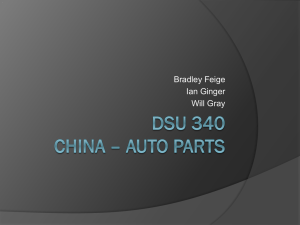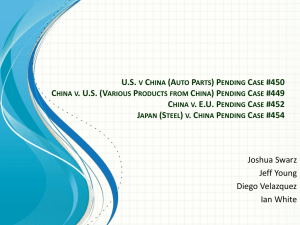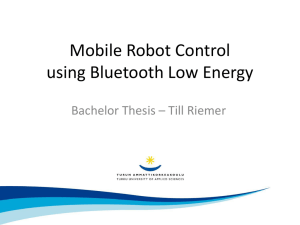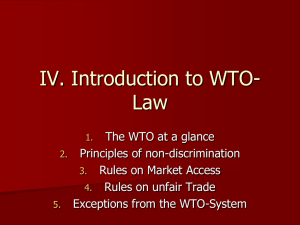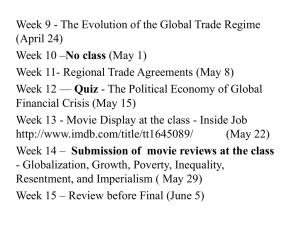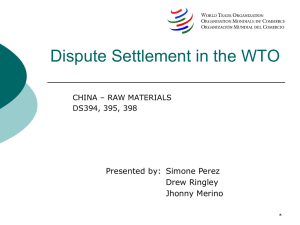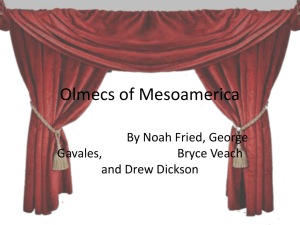team presentation. - International Trade Relations
advertisement
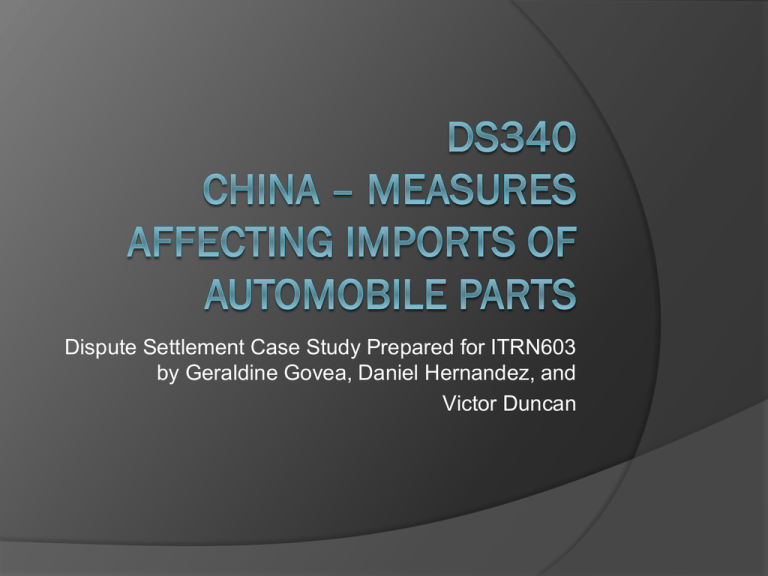
Dispute Settlement Case Study Prepared for ITRN603 by Geraldine Govea, Daniel Hernandez, and Victor Duncan Contents Case History and Context The Main WTO Issue Positions of Involved Parties Panel/AB Decisions/Recommendations Implementations Our Dispute Observations Time for Comments and Questions DS340 Case Origins Under normal circumstances, auto firms would expect to pay a lower tariff at the point of entry for imported auto parts than they would for complete vehicles. If an automobile produced in China was comprised of at least 60% imported parts, the imported parts became reclassified as “complete vehicles”. Because “complete vehicles” were charged higher tariff rates a the point of entry, producers were then subject to a post-entry charge for imported parts as if they were “complete vehicles”. The measures enacted were seen by some exporters to be inconsistent with China’s WTO obligations. Case History: Proceedings March-April, 2006: Complainants requested consultations Consultations failed to resolve dispute September 15, 2006: Complainants requested panel formation Panel formed October 26, 2006 July 18, 2008: Panel circulated report September 15, 2008: China submitted to AB appeal to Panel decision December 15, 2008: AB circulated report Case History: Proceedings January 12, 2009: DSB adopted AB report February 11, 2009: China informed DSB of its intention to conform Political & Business Context China joined WTO in 2001 China’s government initiated measures to protect domestic auto parts manufactures The U.S., along with other parties, made the case that China’s measures were inconsistent with WTO obligations Politics of China’s Auto Industry Company Ownership Dongfeng Motor State FAW Group State SAIC Motor State Chang’an State BAIC Auto State Jianghuai (JAC) State Brilliance Auto State BYD Private Chery Private Geely Private Great Wall Private Politics of U.S./Canada/EC Auto Industries Foreign auto makers dominate China’s market Taken from Wall Street Journal (online.wsj.com) Statistical information on case findings https://www.fas.org/sgp/crs/row/R43071.pdf Statistical information cont. Prior to 2006, Chinese vehicle imports have always been greater or at par with its exports. Between 2006-2008, China’s vehicle exports increased dramatically, which can be associated to additional internal charges added at customs in China. 2006 was when the United States began complaints against China in the WTO. In 2009 China declared that it had brought its measures into conformity with the DSB recommendations and rulings. Graph supports the claim and shows that since 2009, Chinese automobile imports have increased beyond its exports. https://www.fas.org/sgp/crs/row/R43071.pdf The main WTO issues in the most recent proceeding Violation of the sub- principle of National Treatment (GATT Article III) The Appellate Body upheld the Panel's findings that the measures violated: (i) Art. III:2 because they imposed an internal charge on imported auto parts that is not imposed on like domestic auto parts; and (ii) Art. III:4 because they accorded imported parts less favorable treatment than like domestic auto parts by, inter alia, subjecting only imported parts to additional administrative procedures GATT Article II: Schedule of Concessions The Panel found that, even if the “charge” were an ordinary customs duty, it was still inconsistent with Art. II:1(a) and (b) because it corresponded to the tariff rate for motor vehicles (25%), in excess of the applicable tariff rate for auto parts (10%) under China's Schedule. Principal issues continued GATT Article XI: General Elimination of Quantitative Restrictions No prohibitions or restrictions other than duties, taxes or other charges, whether made effective through quotas, import or export licenses or other measures, shall be instituted or maintained by any contracting party on the importation of any product of the territory of any other contracting party or on the exportation or sale for export of any product destined for the territory of any other contracting party. Principal issues continued TRIMS agreement on Quantitative Measures (Article II) Without prejudice to other rights and obligations under GATT 1994, no Member shall apply any TRIM that is inconsistent with the provisions of Article III or Article XI of GATT 1994. An illustrative list of TRIMs that are inconsistent with the obligation of national treatment provided for in paragraph 4 of Article III of GATT 1994 and the obligation of general elimination of quantitative restrictions provided for in paragraph 1 of Article XI of GATT 1994 is contained in the Annex to this Agreement Decree of the People’s Republic of China , No. 125 Decree 125 establishes a uniform system for determining whether an automobile’s shipment of parts should be classified as either a “semiknocked down kit” or a “complete-knocked down kit”. Article 21(1) of Decree 125 provides: Imported automobile parts shall be characterized as complete vehicles if one of the following applies: (1) imports of CKD or SKD kits for the purpose of assembling vehicles. Decree 125 continued Under Decree 125, the duty on a part is assessed following assembly and production, rather than directly upon importation (cf. Arts. 7, 11, 27-35). The level of the duty on imported parts thus depends on their final assembly into a completed vehicle in China. If the imported parts will be incorporated in a car, which, pursuant to Decree 125, does not have sufficient local content, the imported parts will be subject to customs duties that are normally payable on a completely built up imported car (cf. Decree 125, Arts. 21 and 22); the final duty on the parts is only assessed after their assembly into entire automobiles (cf. Art 28); whether a part bears the features of a complete vehicle is determined after the parts have been assembled (cf. Art 5). Decree 125 continued The charges are applicable primarily to automobile manufacturers, rather than the importers of specific auto parts. Manufacturers are responsible for the payment of duties even if the parts were purchased in the domestic market from the suppliers that previously imported them (cf. Decree 125, Arts. 27-35). Decree 125 continued Verification by customs authorities at the site of the manufacturer (cf. Decree 125, Arts. 17-20) occurs following assembly and production. When viewed in combination with the other elements listed here it certainly confirms the internal character of the measures. Finally, duties are levied according to how imported auto parts are incorporated in domestic production (cf. Decree 125, Arts. 21-24). The contested issue of U.S. Complaint by the United States (WT/DS340). On 30 March 2006, the European Communities and the United States, and on 13 April 2006, Canada, requested consultations with China regarding China's imposition of measures that adversely affect exports of automobile parts from the European Communities, the United States and Canada to China. Third Parties: Argentina; Australia; Brazil; Japan; Mexico; Chinese Taipei; Thailand The specific WTO agreement and specific provisions involved. GATT 1994: Art. II, II:1, III, III:2, III:4, III:5, XI:1 Subsidies and Countervailing Measures: Art. 3, 3.1(b), 3.2 Trade-Related Investment Measures (TRIMs): Art. 2, 2.1 Protocol of Accession: Part I, para. 1.2, Part I, para. 7.2, Part I, para. 7.3 The consistency of the contested national act with WTO obligations. We find that the United States’ claims are consistent with WTO obligations, mainly, the principal on National Treatment (GATT Art. II, III, and XI). WTO’s Appellate Body dutifully agrees with China’s inconsistency in practicing WTO obligations and recommended that the DSB request China to bring its measures, found in this Report, and in the US Panel Report as modified by this Report, to be inconsistent with the GATT 1994, into conformity with its obligations under that Agreement (254). China’s Stance Harmonized System (HS) China argues that although the Harmonized system is not formally a part of the Marrakesh Agreement Establishing the WTO, it is closely linked to it and provides the rules and classification of parts which are absent from the GATT 1994 HS provides the decision-making rules for resolving a wide variety of classification issues HS section GIR (a) 2 specifies that an unassembled or disassembled article is classified as the complete article instead of its component parts The charge under the measures (Policy Order 8, Decree 125, and Announcement 4) is based on a valid application of GIR (a) 2 to multiple shipments of parts and components that are linked to each other through their common assembly into the same motor vehicle Using this classification, the charge is seen as an ordinary customs duty since it is based on a proper determination of the product that is subject to the duty assessment Consistency of the measures with Article III: 4 of the GATT 1994 On this point, China argues that any influence auto manufacturers have on using domestic over imported auto parts derives solely from the structure of bound rates in China’s Schedule of Concessions that creates an incentive for automobile manufacturers to assemble vehicles in China from imported parts and components that, in their entirety, do not have the “essential character” of a motor vehicle under GIR 2 (a) The European Communities’ Argument Argument: Under China’s measures, imported auto parts that are used in the manufacture of vehicles for sale in China are subject to charges equal to the tariffs for complete vehicles, if they are imported in excess of certain thresholds The measures are specifically inconsistent with the following: Articles II:1 (a), II:1 (b), III:2, III:4, III:5 of the GATT 1994 Articles 2.1 and 2.2 of the TRIMS Agreement Article 3 of the SCM Agreement China’s obligations under its Accession Protocol The Argument Brought Forth by the United States Argument: The measures introduced by China appear to penalize manufacturers for using imported auto parts in the manufacture of vehicles for sale in China The measures are inconsistent with the following legal texts: Article 2 of TRIMs Agreement GATT 1994 Articles II and III SCM Agreement Article 3 The Protocol of Accession Canada’s Stance Argument: China’s imposed measures cause different charges on vehicles manufactured in China depending on the domestic content of the automobile parts used in the manufacture, thus providing domestic manufacturers with an advantage if they use domestic parts In addition, when enterprises utilize domestic parts they gain an advantage in foreign investment as a result of the measures Further, China would apply the measures to not only completed vehicles, but also CKD (completely-knocked down) and SKD (semi-knocked down) kits. China’s measures are inconsistent with: The Protocol of Accession Articles II and III of the GATT 1994 Article II of the TRIMs Agreement Article II of the Rules of Origin [para. (b), (c), and (d)] Article III of the SCM Agreement The Panel’s Recommendation Separated its findings in the form of a single document containing three separate reports for the European Communities, the United States, and Canada respectively Three common elements among all three countries: a) Regarding imported auto parts in general: Policy Order 8, Decree 125, and Announcement 4 are inconsistent and unjustified b) In the alternative, assuming that the measures fall within the scope of the first sentence of Article II: I (b) of the GATT 1994, the measures are not justified and are inconsistent with Articles II and XX of the GATT 1994 c) With respect to CKD and SKD kits; Policy Order 8, Decree 125, and Announcement 4 are not inconsistent with Article II:1 (b) of the GATT 1994 -The mentioned measures were also found to be inconsistent with China’s commitment under paragraph 93 of China’s Working Party Report Recommendation: The Panel recommends that the Dispute Settlement Body (DSU) bequest China to these inconsistent measures as listed above into conformity with its obligations under the GATT 1994 and the WTO Agreement The Appellate Body’s Decision Through the issuing of a single document consisting of three reports, the Appellate Body (AB) made the following recommendation for the European Communities, the United States, and Canada: A recommendation that the DSB request China to bring its measures, found in the AB December 15, 2008 Report and in the panel reports as modified in the AB report, to be inconsistent with the GATT 1994, into conformity with its obligations under the GATT 1994 Implementation Timeline & Procedures February 11, 2009 China informed the DSB at the DSB Meeting that it intended to implement the DSB rulings and needed an adequate amount of time to do so. February 27, 2009 The European Communities, the United States, and Canada informed the DSB that the appropriate amount of time is 7 months and 20 days, with a maximum expiration date of September 1, 2009 August 31, 2009 China informed the DSB that on August 15, 2009 both its Ministry of Industry and Information Technology and National Development and Reform Commission had issued a joint decree to stop the implementation of relevant provisions concerning the importation of auto parts in the Automobile Industry Development Policy On August 28, 2009 the General Administration on Customs and relevant agencies had declared a joint decree to repeal Decree 125 Seeing as all these new decrees would come into effect on September 1, 2009 China declared that it had brought its measures into conformity with the DSB recommendations and rulings Observations: International Considerations Third Parties: Japan, Australia, Mexico, Chinese Taipei, Thailand, Argentina, and Brazil Argentina Sided with the complainants that the measures are not justified under Article XX of the GATT 1994 Japan Had a substantial trade interest as a result of being one of the major trading partners of China in the automobile sector Mexico As an automobile parts producer, Mexico participated as a third party due to its trade interest in the case Australia Substantial trade and commercial interests due to increasing volume of trade between Australia and China (exports to China increased from AUD 70 million in 2004 to AUD 284 million in 2005) Brazil Raised certain questions such as: how should the Panel characterize China’s Policy Order 8, Decree 125, and Announcement 4 as a matter of WTO Law? Observations of the Dispute in the Global Trading System U.S.-China Relations since the dispute: Despite the resolution in 2009, China’s use of “export bases” has resulted in the accumulation of $1 billion in subsidies between 2009 and 2011 to auto and auto parts exporters Canada-China Relations: As China overtook the United States as the world’s largest automobile market in 2009, Canada’s vehicle exports amounted to USD $49 million in 2009 EU-China Relations: The European Communities (specifically, the EU 27) exports of auto parts to China in 2012 amounted to 653,807.6 Kg Questions? Sources USTR report on Obama’s challenge to China on this case: http://www.ustr.gov/aboutus/press-office/press-releases/2012/september/obama-administration-challengeschina-auto-subsidies Canada-China Business Council article: http://www.ccbc.com/zh-hant/research-reports2/sectoral-research/canada-china-relationship/ European Commission Trade Market Access Database: http://madb.europa.eu/madb/statistical.htm?from=form&format=0&ahscode1=87080000 00&cb_reporters=EU27&cb_partners=0720&list_years=2012&list_years=2011&list_yea rs=2010&cb_measures=iv&cb_measures=iq&cb_measures=ev&cb_measures=eq&cb_ measures=isq&cb_measures=esq&submit=Search GATT 1994, TRIMS, Protocol of Accession WTO Dispute Settlement File for DS340: http://www.wto.org/english/tratop_e/dispu_e/cases_e/ds340_e.htm Dispute Summary Report to the Panel, including all annexes Report to the Appellate Body
